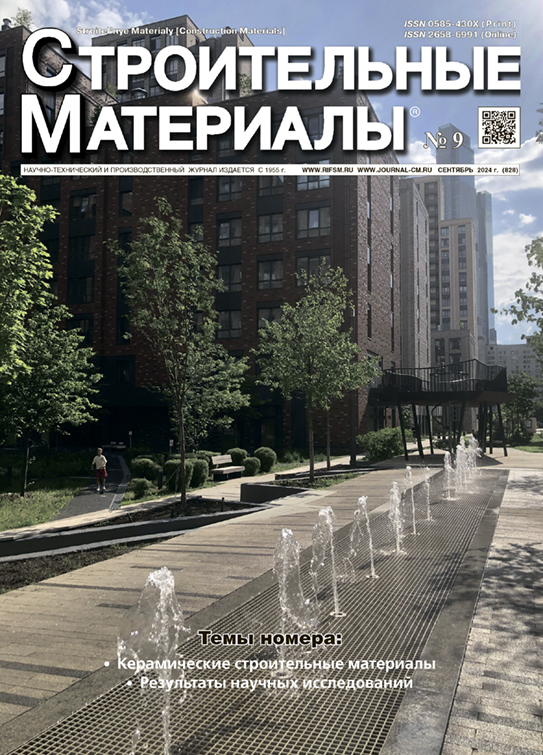Керамические материалы низкотемпературного спекания из природных и техногенных пород Республики Тыва
- Авторы: Стороженко Г.И.1, Сапелкина Т.В.2, Шоева Т.Е.1, Себелев И.М.1
-
Учреждения:
- Новосибирский государственный архитектурно-строительный университет (Сибстрин)
- Тувинский институт комплексного освоения природных ресурсов СО РАН
- Выпуск: № 9 (2024)
- Страницы: 11-15
- Раздел: Статьи
- URL: https://rjeid.com/0585-430X/article/view/636781
- DOI: https://doi.org/10.31659/0585-430X-2024-828-9-11-15
- ID: 636781
Цитировать
Полный текст
Аннотация
За рубежом активно занимаются холодным спеканием материалов, в том числе керамических, представляющим собой механически и термически обусловленный процесс массопереноса, который позволяет осуществлять низкотемпературную интеграцию различных материалов. В работе представлены результаты исследований по низкотемпературному спеканию и оптимизации режимов обжига керамических материалов за счет введения в состав шихты из природных и техногенных пород Республики Тыва комплекса солей c температурой ликвидуса 825оС. Определены оптимальные концентрации солесодержащих добавок в керамической массе, оказывающих влияющие на обжиговые свойства получаемых материалов. Установлено, что введение комплекса солей в керамическую шихту способствует более раннему спеканию камня и получению качественной стеновой керамики при более низкой температуре, что приводит к снижению затрат энергии при обжиге изделий.
Полный текст
Об авторах
Г. И. Стороженко
Новосибирский государственный архитектурно-строительный университет (Сибстрин)
Автор, ответственный за переписку.
Email: baskey_ltd@mail.ru
д-р техн. наук, доцент
Россия, 630008, Новосибирск, ул. Ленинградская, 113Т. В. Сапелкина
Тувинский институт комплексного освоения природных ресурсов СО РАН
Email: sapelkina_geotom@mail.ru
младший научный сотрудник
Россия, 667007, Республика Тыва, г. Кызыл, ул. Интернациональная, 117АТ. Е. Шоева
Новосибирский государственный архитектурно-строительный университет (Сибстрин)
Email: shoeva_geotom@mail.ru
канд. техн. наук
Россия, 630008, Новосибирск, ул. Ленинградская, 113И. М. Себелев
Новосибирский государственный архитектурно-строительный университет (Сибстрин)
Email: i.sebelev@sibstrin.ru
д-р техн. наук, доцент
Россия, 630008, Новосибирск, ул. Ленинградская, 113Список литературы
- Информационно-технический справочник по наилучшим доступным технологиям производства керамических изделий ИТС 4–2023. М.: ГТЦ, 2023. 368 с.
- Шишакина О.А., Паламарчук А.А. Применение плавней в производстве керамических материалов // Международный журнал прикладных и фундаментальных исследований. 2019. № 11. С. 105–109.
- Гурьева В.А., Дубинецкий В.В., Вдовин К М., Бутримова Н.В. Стеновая керамика на основе высококальцинированного сырья Оренбуржья // Строительные материалы. 2016. № 12. С. 55–58.
- Яценко Н.Д., Вильбицкая Н.А., Яценко А.И. Особенности формирования фазового состава и свойств высококальциевой низкоплотной керамики на основе глинистого сырья различного химико-минералогического состава // Известия высших учебных заведений. Северо-Кавказский регион. Сер.: Технические науки. 2021. № 2. С. 75–80. https://doi.org/10.17213/1560-3644-2021-2-75-80
- Довженко И.Г. Интенсификация спекания керамического кирпича с применением побочного продукта алюминиевого производства // Фундаментальные исследования. 2011. № 12 (2). С. 341–344. https://fundamental-research.ru/ru/article/view?id=29085
- Стороженко Г.И. Технология производства изделий стеновой керамики из активированного глинистого сырья: Дис. … д-ра техн. наук. Томск, 2000. 231 с.
- Кара-Сал Б.К. Керамические строительные материалы, полученные обжигом при пониженном давлении (технология, структура и свойства): Дис. … д-ра техн. наук. Новосибирск, 2007. 307 с.
- Курносов В.В., Тихонова В.Р. Колпаковая печь – универсальный агрегат для обжига керамики // Строительные материалы. 2023. № 5. С. 48–52. https://doi.org/10.31659/0585-430X-2023-813-5-48-52
- Biesuz M., Saunders T.G., Grasso S., Speranza G., Sorarù G.D., Campostrini R., Sglavo V.M., Reece M.J. Flash joining of conductive ceramics in a few seconds by flash spark plasma sintering. Journal of the European Ceramic Society. 2019. Vol. 39. Iss. 15, pp. 4664–4672 https://doi.org/10.1016/j.jeurceramsoc.2019.07.036
- Guo J., Floyd R., Lowum S., Maria J.-P., Beauvoir T.H., Seo J.-H., Randall C.A. Cold sintering: progress, challenges, and future opportunities. Annual Review of Materials Research. 2019. Vol. 49. No. 7, pp. 275–295. https://doi.org/10.1146/annurev-matsci-070218-010041
- Galota A., Sglavo V.M. The cold sintering process: A review on processing features, densification mechanisms and perspectives. Journal of the European Ceramic Society. 2021. Vol. 41. No. 9, pp. 1–17. https://doi.org/10.1016/j.jeurceramsoc.2021.09.024
- Grasso S., Biesuz M., Zoli L., Taveri G., Duff A.I., Ke D., Jiang A., Reece M.J. A review of cold sintering processes. Advances in Applied Ceramics. 2020. Vol. 119, No. 1, pp. 115–143. http://dx.doi.org/10.1080/17436753.2019.1706825
- Guo H., Baker A., Guo J., Randall C.A. Cold sintering process: A novel technique for low-temperature ceramic processing of ferroelectrics. Journal American Ceramic Society. 2016. Vol. 99. No. 11, pp. 3489–3507. https://doi.org/10.1111/jace.14554
- Rowe J.J., Morey G.W., Zen C.S. The quinary reciprocal salt system Na, K, Mg, Ca/Cl, SO4; a review of the literature with new data. Washington: united states government printing office, 1972. 37 p. https://pubs.usgs.gov/pp/0741/report.pdf










